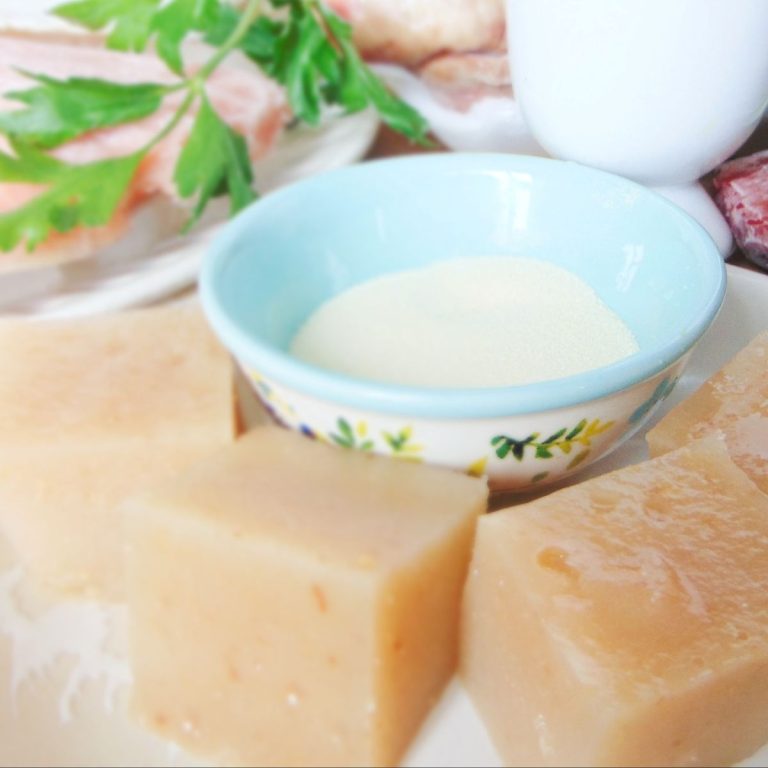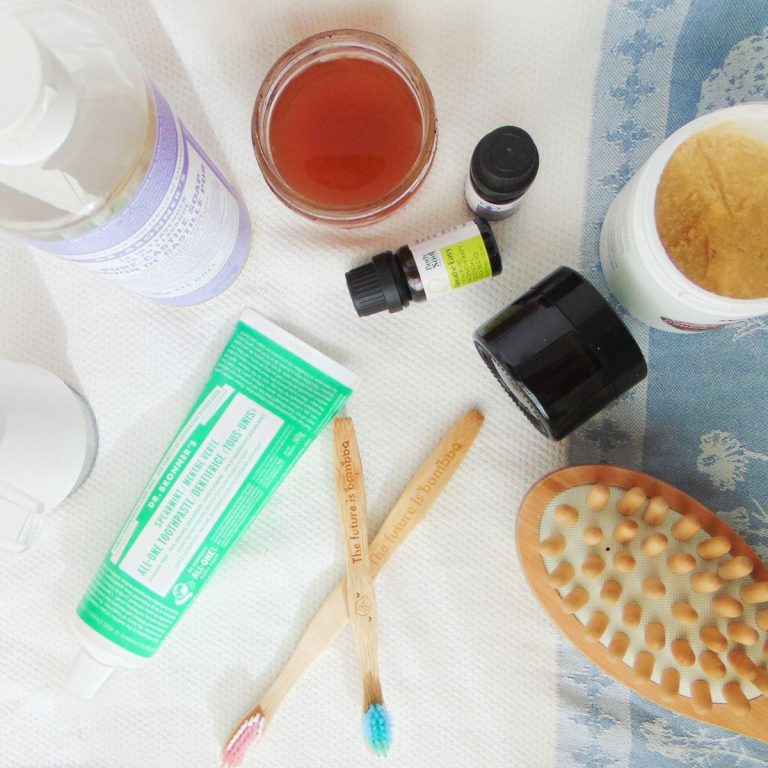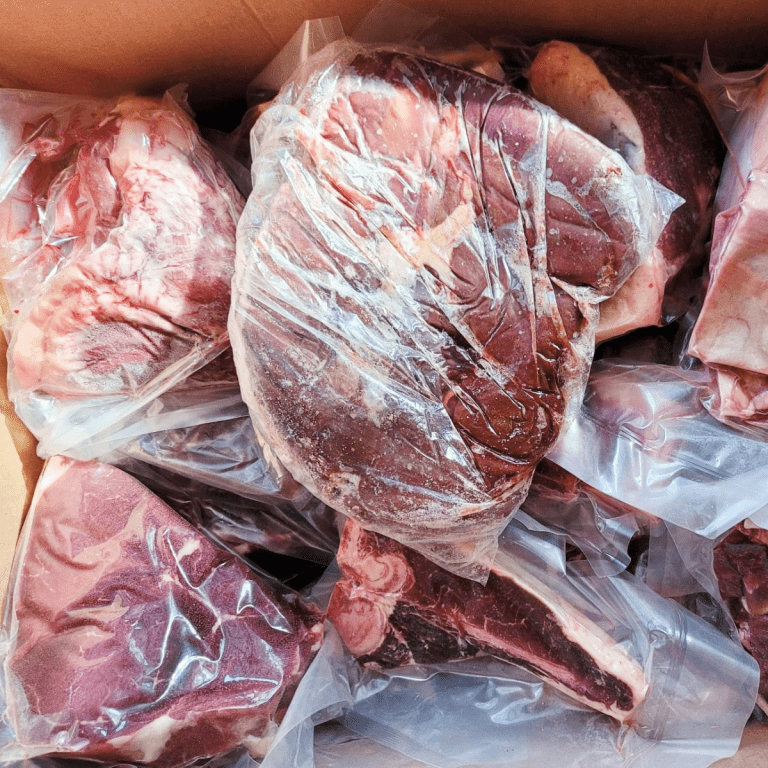Learn how to unlock the incredible benefits of plantain (Plantago major) with this easy, all-natural salve recipe made from infused oil and beeswax. With its soothing, anti-inflammatory, and antibacterial properties, plantain salve can help with a variety of skin issues and is an excellent first-aid staple to keep on hand.

Disclosure: as an Amazon Associate, I earn a small commission from qualifying purchases at no extra cost to you. Read my full Disclosure and Policy here.
Welcome to the world of herbalism! Using plants as natural remedies for you and your family is a fascinating and empowering journey, with a little bit of magic. It can help you become more self-sufficient and change the way you look at those so-called “weeds” growing in your yard!
This plantain salve is a great place to start. Plantain is easy to find, safe to identify, and full of healing benefits. With just a few simple ingredients, you can capture its soothing properties in a gentle, effective, and long-lasting salve.
Make sure to also check out my yarrow salve recipe and how to make a plantain and yarrow salve here!
Keep reading to learn everything about plantain, its benefits, and how to make this skin-loving salve!
What is Plantain?
Not to be confused with the banana-like tropical fruit, plantain is a hardy herbaceous plant from the genus Plantago. The two most common medicinal species are:
- Broadleaf plantain (Plantago major), pictured below
- Narrowleaf plantain (Plantago lanceolata)

Native to Eurasia, plantain was introduced to North America by European settlers and is now widely naturalized. It thrives in compacted soils and disturbed areas like lawns, roadsides, fields, and waste places.
Plantain is a perennial plant with oval leaves arranged in spiral rosettes. Its small flowers grow on upright stalks. When you rip the leaves apart you’ll see stringy white veins.

If you look around your backyard, you’ll likely spot some!
Health Benefits of Plantain
Plantain is a plant with amazing health benefits. The leaves and the seeds of the plantain are edible and rich in vitamin K and C, and calcium (source). It has long been valued in traditional and Indigenous medicine for its many healing properties:
- Anti-inflammatory and antihistamine. Contains tannins, glycosides, flavonoids, and terpenoids. Can helps reduce inflammation and allergic reactions to bug bites and stings.
- Antimicrobial. May helps fight minor infections.
- Antioxidant. Can protects skin from oxidative stress.
- Hemostatic. Helps stop bleeding by constricting blood vessels.
- Drawing agent. Traditionally used to draw out splinters, dirt, pus, or venom from the skin.
Used topically, plantain is traditionally used for cuts, bites, burns, stings, rashes, bruises, and skin irritations. Native American communities embraced it as a versatile healing plant, often chewing the leaves or applying them as poultices to treat painful bruises, rheumatism and headaches (source).
If you ever find yourself out in nature and need a first aid help to stop bleeding or to relieve a painful bite, remember about plantain! You can simply chew some leaves and apply them for quick relief. This salve is a great way to preserve and use plantain’s benefits all year long.
How to Harvest and Dry Plantain Leaves
Harvesting plantain leaves
To harvest plantain leaves simply pinch or cut the leaves at the base, near the stem, or pull the entire leaf with the stem.
The best time to harvest the leaves is in the spring, when they are still young and tender, but you can harvest them from spring to fall as long as they are still green and vibrant. It’s recommended to harvest leaves in the morning before the morning drew dries.
Always pick plantain (or any) leaves from areas that are not sprayed with pesticides, herbicides, or contaminated with animal waste.
If your leaves are contaminated with soil or dust, you can shake or brush off the dirt, or wash them under cold water, drain them, and pat them dry before drying them.

Drying plantain leaves
There are at least two ways to dry plantain leaves.
The easiest way is to air dry them by spreading them in a single layer on a screen, mesh rack, or cloth in a warm, dry, and well-ventilated space away from direct sunlight. You can also tie small bundles of stems with twine and hang upside down. If I don’t have a large amount of leaves to dry, I usually just like to place them on a clean towel or even on a cookie cooling rack on my kitchen counter, picking a spot that doesn’t get direct sunlight or air, and that’s out of the way. In the summer, the leaves typically take about a week to dry.

The other option is to use a dehydrator at a low setting (95–110°F) for 4-1 hours to dry the plantain leaves.
Leaves are ready when they are dry, crispy, and crumble easily. Once the leaves are dried, they can be crushed and stored in an airtight glass jar in a dry, dark place.
What is Plantain Salve and How to Use it
A salve is a thick, oil-based ointment made from infused oil and beeswax. It’s used topically to soothe, protect, or heal the skin.

Plantain salve is made by infusing dried plantain leaves in a carrier oil, allowing the medicinal properties to be extracted into the oil. The addition of beeswax creates a semi-solid, spreadable balm.
It’s safe for adults, children, pets, and even backyard animals, making it a versatile remedy to keep on hand.
Plantain salve can be applied on minor cuts and wounds to stop bleeding, aid healing, and as an anti septic. It can also be used to relieve bug bites, rashes from poison ivy or other irritants, burns, and skin irritations. It can help draw out splinters and venom from bug and snake bites.
If you want to try another healing and soothing DIY salve that’s great for minor cuts, bruises, and much more, try my yarrow salve! You can also combine the beautiful properties of plantain and yarrow and make a plantain and yarrow salve (find my instructions in this post).
This plantain salve is a wonderful natural remedy for anyone who loves spending time outdoors and wants a gentle, effective way to soothe bug bites, scrapes, and minor skin irritations. It’s also a great choice for those looking to reduce toxin exposure and embrace more natural, chemical-free alternatives. I love carrying a small jar of this salve in my backpack for whenever we need it!
Plantain salve is also helpful in relieving diaper rashes, and it may relieve symptoms of eczema and psoriasis, as well as dry and chapped skin. It can also be applied to bruises, and sore muscles and joints to reduce inflammation and speed up recovery.
This homemade, all-natural salve also makes a thoughtful gift for anyone who appreciates simple, natural remedies and herbal care.
Ingredients for this Plantain Salve

Dry plantain leaves. Follow the instructions above for how to harvest and dry plantain leaves. You can also purchase dried plantain leaves. You’ll need about 1/2 cup.
Oil. You need a good carrier oil to infuse the plantain leaves in, which will be the base of this salve. I like using jojoba oil (like this organic, cold-pressed one) for its beneficial properties, long shelf life, and affordability. Other good options include olive oil, avocado oil, coconut oil, sunflower oil, and almond oil. You can also use a combination of different oils.
Beeswax pellets. Beeswax pellets help the oil solidify and turn into a semi-solid cream that’s easy to apply. Beeswax also has moisturizing and healing properties.
Essential oils (optional). You can add a few drops of essential oils for fragrance and added benefits. Good options include lavender, tea tree, and frankincense. Avoid essential oil if you’re sensitive or for using on small children and animals.
Vitamin E (optional). You can add a few drops of vitamin E oil to increase your salve’s shelf life, even though when made with jojoba oil it will already last about 1 year.
Tools you May Need
Jar for infusing oil. Use a heat-resistant jar (like a mason jar) if using the double boiler infusion method.
Double boiler or saucepan and heat-resistant bowl.
Strainer and cheesecloth or clean tea towel.
Tin jar(s) like these 2-oz ones or other kind of jar with lid to store salve.
How to Make Plantain Salve
Make the infused oil
Step 1: Add the dried plantain leave to a clean pint mason jar or other glass jar. Fill the jar to 1/2 to 3/4 full.
Step 2: Add your carrier oil(s) of choice, place the lid on the jar, shake gently to stir, and make sure the leaves are fully submerged. Use at least 2/3 cup of oil, and enough to cover the leaves.
Step 3 (Slow-infusion method): Place the jar in a warm, sunny window or in a dark place. Let the oil infuse for about 2 weeks if placing in a sunny window, or 4-6 weeks if placing in a dark place, shaking the jar gently every few days.

Step 3 (Fast double boiler method): Place the jar (make sure is heat resistant!) in a saucepan with a couple inches of hot water and let the water simmer (not boil!) on low for about 2-3 hours, shaking the jar occasionally.
Step 4: Once your oil is infused, strain through a strainer lined with a cheesecloth or clean tea towel. Use the oil for the salve, or store it in a clean, labeled glass bottle away from heat and light.

Make the salve
Step 1: Add 1.5 tablespoons of beeswax to a double boiler of in a heat-resistant bowl over a saucepan with a few inches of water. Let the beeswax melt, stirring occasionally.
Step 2: Remove from heat and add 90 ml of infused oil and other (optional) ingredients. Stir well until combined.
Step 3: Pour the liquid mixture into your jar(s) of choice and let the salve harden up at room temperature.

Notes
- Always use well-dried herbs to infuse oil and strain the oil very well to avoid the risk of mold.
- The slow-infusion method is considered superior to preserve all the properties of the plants and oils, even though the double boiler method is much faster. Always make sure to keep the oil at a temperature not exceeding 160°F (71°C) if using the double boiler method.
- Label any leftover dried herbs, infused oil, and the salve with date and content.
- Adjust the amount of beeswax slightly if you want a softer or harder texture
- Store the salve in a closed jar in a dry, cool place away from direct sunlight. Shelf life will depend on the kind of oil(s) used. Salve made with jojoba oil can last up to 2 years. Adding vitamin E will extend shelf life, as well as refrigerating the salve.
If you try making this salve, let me know how it turned out and any special uses you might find for it! Drop me a comment down below and don’t forget to leave me a 5-star review if you loved this herbal recipe!
Pin it for Later

More on Healthy LIving and Natural Remedies
Yarrow Salve: Easy DIY Recipe for Soothing and Healing Skin
Health Benefits of Spending Time Outdoors
Morning Sunlight Benefits: Circadian Rhythms, Mood, and More
Tonic and Soothing Drink with Ginger, Honey, and Apple Cider Vinegar
Printable Plantain Salve Recipe Card

Plantain Salve Recipe
Equipment
- Jar for infusing oil.
- Double boiler or saucepan and heat-resistant bowl.
- Strainer and cheesecloth or clean tea towel.
- Tin jar(s) or jar(s) with lid to store salve.
Ingredients
For the infused oil
- ½ to ¾ cup dried plantain leaves
- ⅔ cup (or more) jojoba oil or other carrier oil(s)
For the salve
- 6 tablespoons 90 ml of your plantain-infused jojoba oil
- 1.5 tablespoons beeswax pastilles
- 4–6 drops essential oil optional
- 4–6 drops vitamin E oil optional, as a natural preservative
Instructions
Make the infused oil
- Add the dried plantain leave to a clean pint mason jar or other glass jar. Fill the jar to 1/2 to 3/4 full.
- Add your carrier oil(s) of choice, place the lid on the jar, shake gently to stir, and make sure the leaves are fully submerged. Use at least 2/3 cup of oil, and enough to cover the leaves.
- Slow-infusion method: Place the jar in a warm, sunny window or in a dark place. Let the oil infuse for about 2 weeks if placing in a sunny window, or 4-6 weeks if placing in a dark place, shaking the jar gently every few days.
- Fast double boiler method: Place the jar (make sure is heat resistant!) in a saucepan with a couple inches of hot water and let the water simmer (not boil!) on low for about 2-3 hours, shaking the jar occasionally.
- Once your oil is infused, strain through a strainer lined with a cheesecloth or clean tea towel. Use the oil for the salve, or store it in a clean, labeled glass bottle away from heat and light.
Make the salve
- Add beeswax to a double boiler of in a heat-resistant bowl over a saucepan with a few inches of water. Let the beeswax melt, stirring occasionally.
- Remove from heat and add infused oil and other (optional) ingredients. Stir well until combined.
- Pour the liquid mixture into your jar(s) of choice and let the salve harden up at room temperature.
Notes
- Always use well-dried herbs to infuse oil and strain the oil very well to avoid the risk of mold.
- The slow-infusion method is considered superior to preserve all the properties of the plants and oils, even though the double boiler method is much faster. Always make sure to keep the oil at a temperature not exceeding 160°F (71°C) if using the double boiler method.
- Label any leftover dried herbs, infused oil, and the salve with date and content.
- Adjust the amount of beeswax slightly if you want a softer or harder texture.
- Store the salve in a closed jar in a dry, cool place away from direct sunlight. Shelf life will depend on the kind of oil(s) used. Salve made with jojoba oil can last up to 2 years. Adding vitamin E will extend shelf life, as well as refrigerating the salve.
Disclaimer: The health information shared on this blog is based on personal experience and research, and is not intended as medical advice. Always consult with a qualified healthcare provider before making changes to your health routine. This salve is a traditional herbal recipe intended to be used as a mild, topical remedy for minor skin issues, if you have concerns like deep wounds or infections, consult a healthcare provider.







This sounds wonderful, I love making my own salves. I learned so much I didn’t know about plantain. I’ve had plantain chips but never realized all the other amazing benefits. Thanks for sharing!
Oooh, what a fun gift idea! Thanks for sharing!
I was just out looking g for a natural salve to buy, it never crossed my mind that I could make my own!! Thank you so much for sharing!
I love DIY health and wellness tips! This salve seems amazing. Thank you for sharing- I had never heard of plantain leaves or their healing power!
Plantain is such an incredible plant. And I love how its so readily available pretty much anywhere. I’ve chewed and used it on cuts and bee stings. But I have yet to make a salve with it. And thank you for reminding me that it is a drawing herb. I learned that a long time ago, but somehow forgot about it, and could have used it recently on a really horrible looking infected tick bite. Lemon balm and thyme did take care of it eventually, but I think plantain would have been the thing to try. I love your simple recipe and the instructions are easy to follow, this is a fantastic article on plantain and its benefits and a great salve recipe!